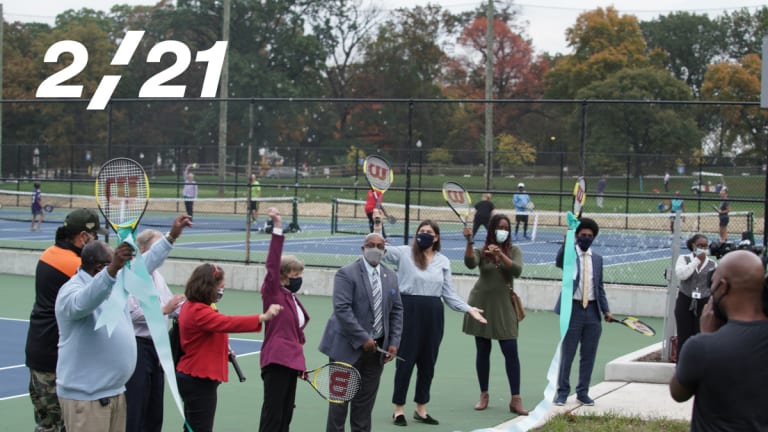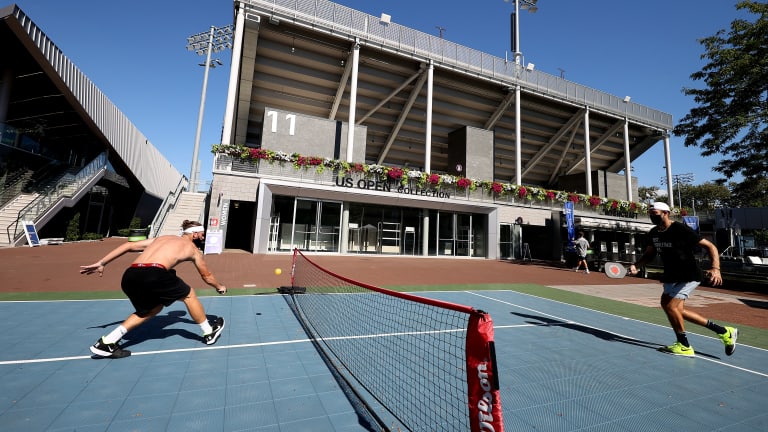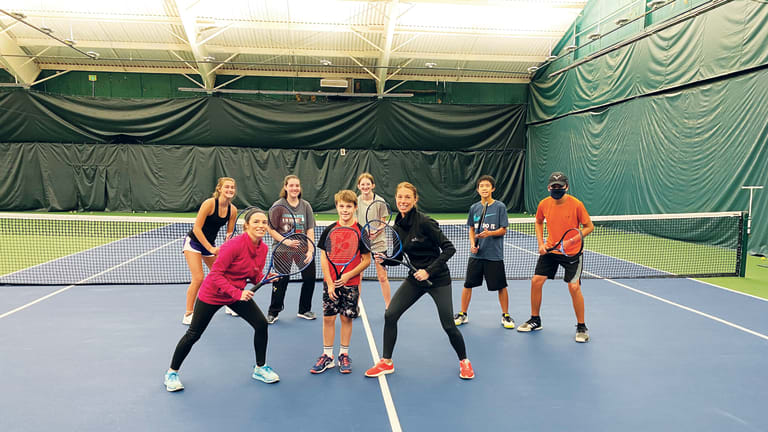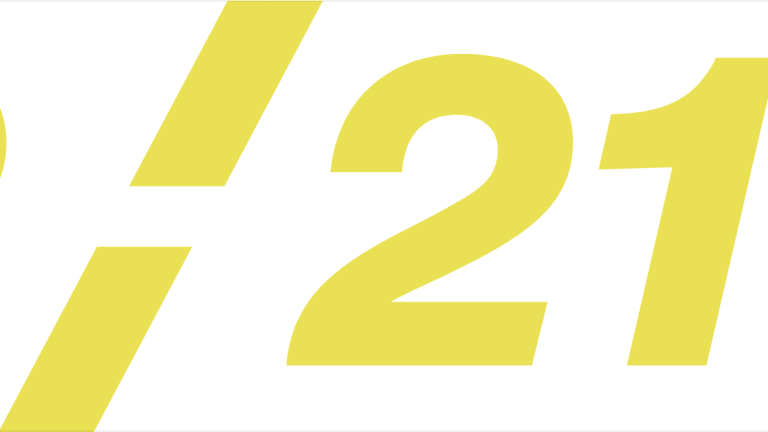The Rally: Discussing the resurgence of rec tennis in the U.S.
Feb 24, 2021Holger Rune ousts Casper Ruud in Barcelona, thanks social media for making H2H a 'big deal'
By TENNIS.com Apr 18, 2025Play suspended in Barcelona when the wrong racquet gets taken for stringing
By Liya Davidov Apr 17, 2025Serena Williams named to Time's 100 most influential people ... and Coco Gauff approves!
By Baseline Staff Apr 17, 2025Jelena Ostapenko tops Emma Navarro for Iga Swiatek Stuttgart clash; Coco Gauff, Jessica Pegula roll
By TENNIS.com Apr 17, 2025Who is Diego Dedura-Palomero? Meet Germany’s latest teenage star
By Emma Storey Apr 17, 2025Rafael Nadal to be honored with 'exceptional' tribute on opening day of Roland Garros
By Associated Press Apr 17, 2025Mirra Andreeva belts 'Happy Birthday' song to coach Conchita Martinez in Stuttgart
By Baseline Staff Apr 16, 2025Ben Shelton uses altitude to his advantage, joins Alexander Zverev in Munich quarterfinals
By TENNIS.com Apr 16, 2025Iga Swiatek in Stuttgart: From clay court to carpool karaoke!
By Franziska Bruells Apr 16, 2025The Rally: Discussing the resurgence of rec tennis in the U.S.
The question for 2021 is: How do we keep these new players in the sport?
Published Feb 24, 2021
Advertising
The Rally: Tennis participation in the U.S. skyrocketed in 2020. The question for 2021 is: How do we keep these new players in the sport? Joel Drucker and Steve Tignor discuss strategies.
Hi Steve,
How intriguing it was earlier this month to see the USTA send out a news release announcing significant increases in recreational tennis activity. Participation over the last year rose by 22 percent.
As the data shows, in a socially distanced environment, with gyms closed and many other forms of exercise quite dangerous, tennis is quite workable.
No doubt executives within the tennis business are trying to figure out what to make of this resurgence. Is it simply a pandemic-related blip? Or might there be broader implications that could provide lessons for everyone from coordinators to instructors, facility managers, equipment manufacturers and even those involved with the pro tours?
In talking with various players and instructors across the country, it’s refreshing to see a strong emphasis on learning, enjoyment and local play over the narrow, highly outcome-focused act of gearing up to travel and compete in a league match. My friend Joe, an ardent tournament player, told me last summer, “With competition off the table, this is the best time to work on improvements.” Call it the research and development phase. A veteran teaching pro noted that in the absence of leagues, far more members are playing singles—and also playing more with one another. Ducking, the hidden poison of many a tennis community, is far less viable in our current environment.
But of course, those insights cited come from the world of active recreational play—that is, people who likely were playing several times a month before the pandemic.
The USTA release said that, of the 21.64 million Americans who played tennis last year, 6.78 million were new and returning players. How does all that play out among various age groups, genders, regions? And what’s going on with the other 14 million? While the qualitative aspect of their tennis experience has been altered, are these men and women indeed taking more lessons or putting money into tennis other ways? All that data has tremendous implications for how various sectors of the tennis business shape their marketing strategies. Might there be new and better ways to keep tennis growing?
And then there’s this: The resurgence has taken place during a time when the spectator piece has been shattered. From March to August last year, no ATP or WTA events took place. Once tennis returned, attendance was non-existent at the US Open and will likely be minimal at other pro events throughout 2021. To be sure, millions still enjoy watching the pros. And these are highly unusual circumstances. Still, the notion that a robust pro game can drive participation is not necessarily a given. That said, might an American tournament director look at these increases in recreational play and think more creatively about how to build a more dynamic connection between the desire to sell tickets and the current climate of recreational zeal?
What do you make of this resurgence, Steve?

The Rally: Discussing the resurgence of rec tennis in the U.S.
Advertising
Hi Joel,
“Retention” is a word you hear a lot in the tennis industry these days. Now that people have been flooding into the sport for a year, how do we keep them from flooding back out? Tennis has always struggled in this regard, for a number of reasons. It takes time and patience to learn. It’s something you do on your own, rather than on a team with your friends, which makes it easier to give up. And the quickest way to get better—taking lessons—generally isn’t cheap.
Yet the people I’ve talked to at the USTA are more optimistic about keeping this group. One reason is similar to what you said above: With fewer competitive outlets, there’s more emphasis on learning the game, joining a community, and fitness. Those are aspects of the sport that hardcore players typically scoff at, but they’re a huge draw for many more people, especially now, when community and exercise are so hard to find. Another reason for hope is that a person or a family that picks up an activity because of its safety may be more willing to stick with it than someone who tries it out of curiosity.
The key, it seems to me, is to get people into tennis programs as quickly as possible. To encourage them to come with friends and family, and to sign up for a regularly scheduled tennis session—whether it’s a match, a lesson, a cardio workout—each week. In the past, the USTA has focused on getting people into its own programs and leagues; now it says it’s going to simply encourage people to play wherever and however they can. That makes sense to me: I picked up squash when I was in my 30s, and a big part of the immediate appeal was how easy it was to find an informal group of players my own level and immediately be welcomed into their social circle.
You mention the pro game. I think most of us have believed, ever since Chris Evert arrived and the tennis boom in this country followed, that watching the pros helps drive participation. But that obviously isn’t true for something like pickleball, which has seen skyrocketing numbers of new players in the last decade.
One of the appeals of pickleball is that it’s easier to learn and less physically taxing than tennis. Of course, tennis players are proud that our sport isn’t easy, and take satisfaction in mastering it. Which makes me wonder (a) if there’s a way to get people who already play pickleball or paddleball to think of those games as a springboard to tennis; and (b) if there’s a way to make tennis easier to learn. I know a lot of pros now use the much-maligned Quick Start equipment—smaller courts and softer balls—with their adult beginners, and that this provides an easier path to success.
Still, tennis will always require patience to learn. Which is a trait Americans would do well to cultivate, don’t you think?
What do you think the key to retaining players is, Joel?

The Rally: Discussing the resurgence of rec tennis in the U.S.
© Getty Images
Advertising
Steve,
No question, a sport as skills-based and simultaneously personal and communal as tennis requires significant programming—that is, directed activities.
And the biggest starting point for this is at community tennis centers. After all, someone who’s either just started the game or is just returning to it isn’t that likely to instantly join a club.
So I’m in sync with you about the instructional component, including the fun ways Quick Start equipment can get people of all ages into the game in a way that’s engaging and edifying. I love the idea of people aspiring to learn the game getting familiar with the entire court.
But I also think those who run tennis communities—be it at a public park or a private club—need to undergo a major revolution in how they approach their job.
A major reason people leave tennis is that they can’t find people to play with. Pick-up basketball? Yes. Pick-up pickleball? It’s happening. Pick-up tennis? A tough go. Whether at stuffy clubs or cliquish parks, there is an enduring layer of insularity to this sport that is often a major turn-off.
And this is where the people in charge of tennis facilities need to think differently. The opportunity: to see instruction as something far greater than learning how to hit the ball well. A better approach: instruction as an education about what the game is all about.
Facilities thrive when those operating them view themselves less as teachers of strokes and more as community builders. When a new person shows up, do they welcome them, find hitting partners, potential foursomes? What about fun, fast-paced events like a Saturday afternoon tie-breaker shootout? Or a post-Australian Open Zoom clinic discussing what can be learned from the greats? Granted, the current pandemic makes some of these ideas a little tricky to pull off, but the idea remains: get people excited about tennis.
Along with that, I’d like to see a Tennis Bill of Rights that blunts the snobbery so pervasive in our sport. Recreational tennis players need to be far more welcoming of players with a wider range of skills, not just for the good of the game’s economy, but also so they can improve. For example, the notion that you only get better when you hit with better players is a myth that should be blown to smithereens. And just like some political reformers crusade for term limits, how about the idea of never repeating the same doubles foursome more than three consecutive weeks? Again, I want more people mixing with one another.
But the catalyst for this can best be that person running the facility. He or she is the one setting the tone, organizing the formal and informal ways to turn a series of disparate courts into a friendly, inclusive community. It’s not easy, and it’s not as swiftly rewarding on the financial front as strictly giving lessons. But over the long haul, the benefits will be far greater. That to me is what retention is all about.
Steve, what are your ideas about what a thriving tennis community looks like?

The Rally: Discussing the resurgence of rec tennis in the U.S.
Advertising
Joel,
Those are good points. Whether it’s because of the physical layout of a facility, or the attitude of the players on the courts, there’s a sense of separation built into playing tennis. I’m on this court, and you’re on that court, so we never need to get to know each other. In fact, it’s more likely we’ll get annoyed at each other when our mishits fly from one court to the next and disrupt play.
I’ll return to squash again because it offers a useful contrast in this regard. After growing up in the tennis world, I was pleasantly surprised by how willing squash players of different levels are to play each other, and how much socializing there is across cliques. The sport seems to naturally break up cliques rather than help them form.
I think that starts, accidentally enough, with the layout of a squash facility. The exits to the courts are all in a row, so when you take a break between sets, you walk out the door of your court and run right into everyone else who is in the club that day. Soon you’re talking to them around the drinking fountain, and then rotating in and out of each other’s matches, playing pick-up round-robins.
At the center of this community are the squash pros, who, when they aren’t giving lessons, are hanging out, watching people play, getting to know the regulars and, ideally, helping them connect with other players they know. I think that’s what you’re talking about, Joel, when you say you want teaching pros to think of themselves as community builders.
There are tennis pros who think of their jobs this way, and plenty of clubs with thriving communities. While tennis facilities may never lend themselves to instant socializing, the pickleball craze has led to more multi-racquet-sport facilities being built. I think that can only be good for tennis.
So how do we encourage players of different levels to take the court together? How do we get the good players to put aside their snobbery, and the not-so-good players to ignore their fear of embarrassment? One answer is to create a handicap system, à la golf; it has been tried in the past, but has never taken off in tennis. I’ve used a simplified system on a number of occasions and found that it can work well. I’ve played practice matches where I’ve started every game 0-15, and ones where I’ve started every game up 15-0, and it does keep things competitive. It can feel like a real match.
Perhaps the more important question is this: How do we make tennis about more than competition? Wherever I’ve played, singles matches have been the core of the game; nothing else really counts. Can we get past that attitude, and make all formats—doubles, drilling, cardio workouts, mini-tennis, baselines games, etc.—seem equally important? This could be a way to encourage highly skilled players to lower themselves and take the court with opponents who normally couldn’t give them a match. As I’ve grown older, I’ve found that the feeling I get after a tennis workout is just as satisfying as the one I get after winning a match, and more stress-relieving.
Singles, doubles, mixed, cardio, drills, or just hitting: The sport should have something to offer all of its new players.
Nestled between January's summer swing of tournaments in Australia, and March's Sunshine Double in the U.S., February can be overlooked in tennis. But not in 2021, with the Australian Open's temporary move to the second and shortest month of the calendar. Beyond that, February is Black History Month, and also a pivotal time for the sport in its rebound from the pandemic.

The Rally: Discussing the resurgence of rec tennis in the U.S.
Advertising
To commemorate this convergence of events, we're spotlighting one important story per day, all month long, in The 2/21. Set your clock to it: it will drop each afternoon, at 2:21 Eastern Standard Time (U.S.).